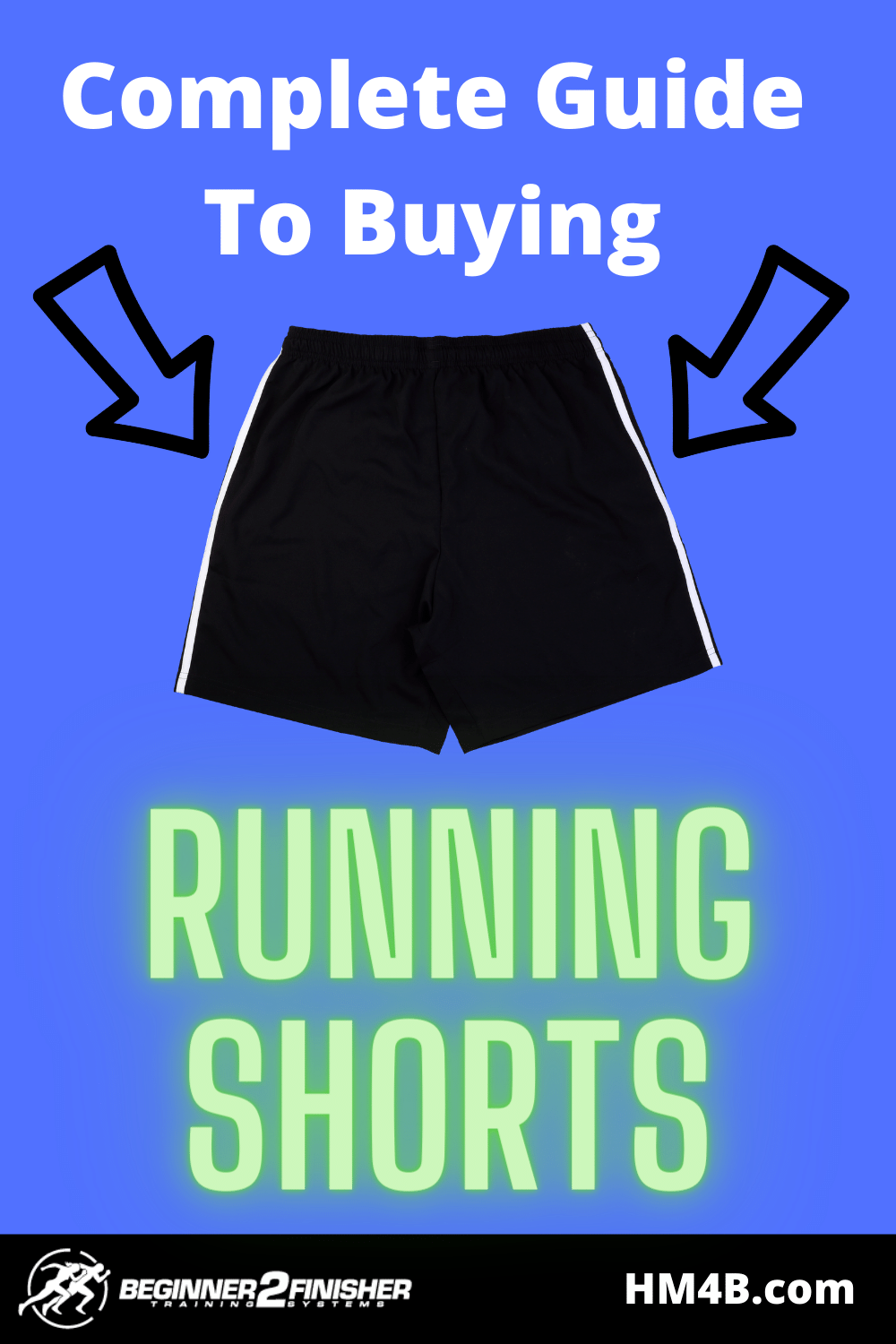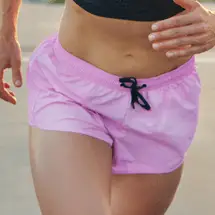There are many factors to consider when buying running shorts, including style, material, length, and any additional features you may want or need. Not all running shorts are built the same, and choosing ones that work for you is essential.
When you understand the reasons that running shorts are built differently you can save yourself stress, time, and money. Check out this complete guide to buying running shorts before you buy another pair to get a clearer idea of what you want and need.
Check out my complete review of men’s running shorts here.
Check out my complete review of women’s running shorts here.
Different Styles of Women’s Running Shorts
While running shorts tend to come in the same style for both men and women, there are benefits to choosing a pair of shorts suited to your biological anatomy. Manufacturers also tend to design shorts in different ways depending on gender, and knowing these differences can help you choose a pair better suited to you.
Compression Shorts
On a basic level compression shorts fit tight to the body and are usually made of a synthetic fiber like Spandex. These resemble cycling shorts, but you find more variation in length and no padding at all.
Because they are tighter compression shorts tend to be warmer and they support your muscles more. They also prevent chafing because there is no loose material to rub against your skin.
Length is always a matter of preference, but women’s compression shorts tend to be shorter. You can find them as short at a 1-inch inseam, but longer bike-style shorts have been coming into style.
V-Notch Shorts
V-notch shorts are looser than compression shorts but not so much that they cause undue irritation. As you may have guessed from their name, these have a v-shaped notch cut out on the outer leg seams.
The v-notch allows for a better fit and increased mobility. Women’s v-notch shorts tend to have shorter inseams, and they fit better to the waist and hips of those with female anatomy.
Split Shorts
These offer the largest range of mobility because they lack a strict seam on the outside of the thighs. Instead, the front and rear panels of the shorts overlap and are secured somewhere along the top of the shorts.
The split tends to differ in length. It can go all the way up to the waistband, or you may find a pair with a short split that is barely there. Keep in mind that the longer the split is the more range you will have.
Women’s split seam shorts are more likely to have a deep split, and they better accommodate a woman’s waist, hips, and thighs.
Are you looking for women’s running shorts? Check out my complete review of women’s running shorts here.
Different Styles of Men’s Running Shorts
Men’s running shorts fall into the same basic categories as women’s, but there are a few differences in the styles between genders.
Compression Shorts
Men’s compression shorts are much more similar to what you would think of like bike shorts because they tend to have a longer inseam. The most common length for men’s compression shorts is mid-thigh to the knee.
Although compression shorts offer the necessary support for the groin area, you are less likely to see these in use on their own. Most will pair compression shorts with a looser style of shorts.
Related: Are there any benefits from wearing compression socks?
V-Notch Shorts
V-notch shorts on men still run a longer length and they are sized better to fit male hips and thighs. These are more likely to have pockets than compression shorts because of their versatility.
You can also find more support in the waistband of v-notch shorts, and they will be less constricting on thighs.
Split Shorts
While most split shorts are shorter you will still find men’s split shorts to be longer. They are also less likely to have a deep split on the seam.
For the most part, men’s split shorts closely resemble v-notch shorts. Pay close attention to the side seams of shorts to ensure they offer an increased range of motion.
Running Shorts Materials
If you have taken the time to check out the fiber content of your clothing then you might notice workout clothes seem a bit more complicated. This is because the fibers that are most commonly used with athleticwear are synthetic, so they do not have familiar names like some of your clothing.
You have options for both natural and synthetic fibers when it comes to running shorts, and they have their pros and cons.
Natural Fibers
You are less likely to see natural fibers on workout clothing for a few reasons.
They do not manage sweat very well because natural fibers, particularly cotton, are quick to soak up any moisture. When you combine this tendency with perspiration and humidity you will find yourself miserable in no time at all. Moisture retention tends to leave runners cold, and it contributes to chafing.
Natural fibers are also weaker in high heat, so your investment may not last as long as you want.
What are they good for? Natural fibers can offer you more freedom to move, and you will find less resistance as you take your strides. They also tend to stink less because they retain odor less than synthetic fibers.
Synthetic Fibers
These are the popular choice for athleticwear, and you can see synthetic fibers under names like:
- Elastane
- Spandex
- Nylon
- Polyester
Because they are stretchier, synthetic fibers seem to fit better than natural fibers. They are better at wicking away moisture and hold up better in most conditions, including the normal wear and tear that comes with running.
They are more prone to odors, and you will meet more resistance with these fibers.
Are you looking for women’s running shorts? Check out my complete review of men’s running shorts here.
Different Running Short Lengths (and Why it Matters)
Beyond style preference, the different lengths of running shorts are ideal for different conditions. Shorts have different lengths of inseams. This number refers to the measurement from the seam at the base of the crotch to the inside base of the thigh.
Inseam is a fantastic number to refer to when trying to discover how shorts will fit, especially when shopping online. There are three basic lengths (short, medium, and long), and they have different performance benefits.
Short
A short inseam usually refers to something 3 inches or shorter. These offer the best range of motion, and they are preferred by competitive runners.
Short inseams are a great choice for sprints or longer distances because they interfere less with the natural range of motion. They are lightweight and tend to offer the best ventilation with the least amount of restriction.
Medium
Medium-length shorts are a happy middle ground for most runners. At 5 inches they hit mid-thigh on most people, and they are a great choice for those who tend to run in different conditions and do not want to invest in a variety of shorts styles.
Because these are great compromise options this is also where most runners can start. Even if you decide you like your shorts shorter or longer, you should not be too far from what you need.
Long
Long shorts are about 7 inches, and they hit just above the knee in most cases. These are better for shorter distances or routes that have special conditions. If you need protection from debris you are better off with longer shorts.
Make sure that this length is not made of anything that will trap moisture. Because they cover more of your body you want something that will wick away moisture and keep you cool.
Additional Features
On top of the main features of style, material, and length some additional features and preferences can be tagged on to any of the shorts mentioned before. These are:
- Visibility
- Sun protection (UPF)
- Pockets
These may seem like premium features, but you will find that they come in pretty handy, especially with regular use.
Visibility
Visibility is especially important if you intend to run early in the morning or late at night when there is little light to help others see you. This can be resolved first by wearing lighter colors, but plenty of brands offer reflective features on their shorts to help you out.
Whether this means the entire garment is reflective or just the seams, something is better than nothing.
Related: How To Stay Safe Running At Night
Sun Protection (UPF)
You probably already know that sunscreen is important because it helps block harmful UV rays from damaging your skin, but did you know that you can find the same protection in clothing? On garments, this is referred to as Ultraviolet Protection Factor (UPF).
For running shorts, you should opt for a UPF of at least 50. More is always better, but this is the point where roughly 98% of UVA and UVB rays are blocked, so it is the most efficient for what you pay.
Clothing with UPF works in conjunction with sunscreen, but it does not replace it. Looking for the best mineral-based sunscreens – check out my review on the best mineral sunscreens for runners.
Pockets
The last thing to consider when buying running shorts is whether they have pockets or not. You should not need to carry much when you are running, but keeping your phone and keys on your body is pretty important.
Most shorts meet this need by incorporating a small zippered pocket on the waistband. Longer shorts tend to have larger pockets.
The Most Popular Style of Running Shorts
When it comes to running shorts it can be hard to determine which style is most popular. This is because running shorts are bought based on preference and body type, and there are so many variations when it comes to runners.
For the most part, however, people tend to play it safe with v-notch shorts in medium length. This is the safest space to start when shopping for running shorts because you get decent mobility without going too short or too long.
This may not work for you, so take your preferences and needs into consideration before falling in love with the next running shorts you see.
Related: What Should I Wear For My Marathon Race?
References
https://rightasrain.uwmedicine.org/body/exercise/run-night-tips-keep-you-running-safely



5 thoughts on “Complete Guide To Buying Running Shorts”